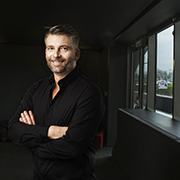“Splendour” could stand as the heading for Matthias Pintscher’s last composition in his “Shirim” cycle, which now receives its premiere as a complete work.
As the fourth part and conclusion of his Shirim cycle, Matthias Pintscher has set the third chapter of the Song of Solomon for baritone, chorus and orchestra. In this, there is mention of splendour, the entrance of King Solomon himself, of the costliness of the treasures and robes, the shimmering gold swords of his accompanying retinue: “King Solomon made himself a chariot of the wood of Lebanon. He made the pillars thereof of silver, the bottom thereof of gold, the covering of it of purple; the midst thereof being paved with precious stones. Go forth, O ye daughters of Jerusalem and behold ...”
The third chapter of the Shir-ha-shirim is characterised by its sense of contemplation. Matthias Pintscher: “It is largely a description of a situation. The plot has less action than in the other six parts of the Song of Solomon. Here I am interested in sensing a situation which has something very archaic about it: the blades of the swords, the metallic is defining, the description of the sounds, colours, smells.”
Pintscher has composed the sections of the cycle over a period of ten years, beginning in 2008 with the fifth song in she-cholat ahava ani (For I am sick of love) for mixed unaccompanied choir, followed in 2011 by the second song in songs from Solomon’s Garden and in 2017 with the third part of Shirim, both for baritone and orchestra. All four parts will be performed in the complete performance at musica viva Munich.
The poetry is characterized by its floating multiple voices, combining several narrators. This principle is carried to the greatest dimensions in Shirim IV. The dialogue form is extended into an exchange of three elements – baritone, chorus and orchestra. “In the course of the work, the texture initially becomes denser, more concentrated and constantly simplifies until the gates open at the end. The keyword ‘splendour’ is very important. The whole cycle is characterized by a circling of very many elements which are extremely coherent in themselves – the harmonies, the orchestration, the gestures. Here in this movement the metallic repertoire above all is extended, something which had been prefigured in my piano concerto NUR.”
Marie Luise Maintz
(from [t]akte 2/2019 – translation: Elizabeth Robinson)



